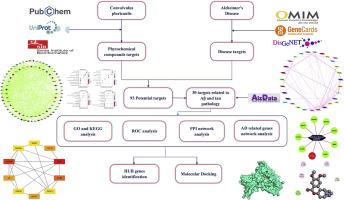旋覆花对阿尔茨海默病的治疗机制:网络药理学和分子动力学方法
IF 2.7
3区 生物学
Q2 PLANT SCIENCES
引用次数: 0
摘要
阿尔茨海默病(AD)是一种痴呆症,在老年人中最为常见。作为一种多年生草本植物,Convolvulus pluricaulis Choisy(C. pluricaulis)被用作治疗阿尔茨海默病和其他神经退行性疾病的传统民间药物,但其治疗作用机制尚未确定。本研究试图通过研究白花蛇舌草的植物化学成分及其对AD的影响来阐明其作用机制。为了筛选 C. pluricaulis 的活性成分,采用了口服生物利用度 (OB) ≥ 30 % 和药物相似度 (DL) ≥ 0.18 的值。STRING 和 Cytoscape 平台被用来构建靶标和化合物的互动网络。该网络由 Cytohubba 进行分析,而 GO 功能、KEGG 通路和代谢通路富集则由 SRplot 进行分析。利用 CytoHubba 通过最大剪辑中心度(MCC)和度数确定了有效靶标。通过 Alzdata 数据库确定了淀粉样β蛋白(Aβ)、Tau 病理学与高效靶点之间可能存在的相关性,最后对核心靶点进行了分析。通过分子对接分析和分子动力学(MD)模拟,进一步确定了活性成分与核心靶点的结合亲和力。通过网络药理学方法,我们确定了细胞图谱中的关键基因。C. pluricaulis针对30种信号通路和与AD相关的疾病。根据本研究的总体结果,我们发现所有 4 种生物活性化合物都以 GSK3β 为靶标,在分子动力学模拟中,蛋白质配体复合物在 100 ns 内稳定,并在轨迹上表现出相对论构象动力学。因此,本研究表明,在经过必要的验证后,用天然化合物调节GSK3β是治疗AD和其他神经退行性疾病的一种有吸引力的方法。本文章由计算机程序翻译,如有差异,请以英文原文为准。

Therapeutic mechanism of Convolvulus pluricaulis against Alzheimer's disease: Network pharmacology and molecular dynamics approach
Alzheimer disease (AD) is a type of dementia most prevalent in the elderly. A perennial herb, Convolvulus pluricaulis Choisy (C. pluricaulis) is used as a traditional folk medicine to treat AD and other neurodegenerative diseases, but the mechanism of action for its treatment has not been determined. This study attempts to clarify the mechanism of AD by investigating the phytochemical constituents of C. pluricaulis and their effect on it. In order to screen the active components of C. pluricaulis, values of oral bioavailability (OB) ≥ 30 % and Drug Like (DL) ≥ 0.18 was used. STRING and the Cytoscape platform have been used to construct an interactive network of targets and compounds. The network has been analyzed by Cytohubba, whereas GO functionality, KEGG pathways and metabolic pathway enrichment were performed using SRplot. The efficient targets were identified via Maximal Clique Centrality (MCC) and Degree using CytoHubba. The possible correlation between amyloid β-protein (Aβ), Tau pathology and identified efficient targets was determined via Alzdata database, and finally the core targets were analyzed. Molecular docking analysis and molecular dynamics (MD) simulation was further used in order to determine the binding affinity between the active ingredients and the core targets. Through a network pharmacological approach, we identified key genes in cytoscape. C. pluricaulis targets 30 signaling pathways and diseases associated with AD. Based on the overall results of the present study, it was found that all 4 bioactive compounds were identified to target GSK3β, and protein-ligand complex was shown to be stable for 100 ns in a molecular dynamics simulation and exhibited relativistic conformational dynamics on the trajectory. Thus, the present study suggests that modulating GSK3β with natural compounds is an attractive approach in treating AD and other neurodegenerative diseases after required validation.
求助全文
通过发布文献求助,成功后即可免费获取论文全文。
去求助
来源期刊

South African Journal of Botany
生物-植物科学
CiteScore
5.20
自引率
9.70%
发文量
709
审稿时长
61 days
期刊介绍:
The South African Journal of Botany publishes original papers that deal with the classification, biodiversity, morphology, physiology, molecular biology, ecology, biotechnology, ethnobotany and other botanically related aspects of species that are of importance to southern Africa. Manuscripts dealing with significant new findings on other species of the world and general botanical principles will also be considered and are encouraged.
 求助内容:
求助内容: 应助结果提醒方式:
应助结果提醒方式:


